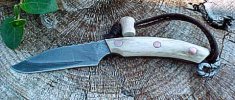-
The BladeForums.com 2024 Traditional Knife is ready to order! See this thread for details: https://www.bladeforums.com/threads/bladeforums-2024-traditional-knife.2003187/
Price is$300$250 ea (shipped within CONUS). If you live outside the US, I will contact you after your order for extra shipping charges.
Order here: https://www.bladeforums.com/help/2024-traditional/ - Order as many as you like, we have plenty.
You are using an out of date browser. It may not display this or other websites correctly.
You should upgrade or use an alternative browser.
You should upgrade or use an alternative browser.
Question about choils
- Thread starter Dexter Ewing
- Start date
dogboye
Gold Member
- Joined
- Nov 23, 1999
- Messages
- 7,158
Originally posted by Normark
On the other hand,,another #7 may be in order..
Hey Eric, if you can find one (a Basic #7) anywhere, please let me know. I have been looking and can't find them anymore. I know they were discontinued (or I heard that), and apparently they are pretty rare (nonexistent?).
- Joined
- Dec 14, 1998
- Messages
- 4,870
Great on big knives.
Nice on small knives to.
I like them . They allow the blade to be sharp all the way to blade end.
Nice on small knives to.
I like them . They allow the blade to be sharp all the way to blade end.
- Joined
- Aug 19, 2000
- Messages
- 643
The way I make knives there's almost always a choil, but there doesn't have to be a ricasso. Here's a pic for an example. In my opinion, the ricasso starts at the handle end of the choil. So, in this case, there isn't a ricasso. But the choil is a finger groove is a choil. Am I off base here or can I hear an amen?
For the longest time I thought the choil was the little notch in front of the plunge line or just in front of the ricasso. Spanish notch huh? I like that!
For the longest time I thought the choil was the little notch in front of the plunge line or just in front of the ricasso. Spanish notch huh? I like that!
Attachments
- Joined
- Aug 19, 2000
- Messages
- 643
Thanks Vel! Zessstaaaayyyyy right back atcha!!
Then again, now that I think about it you could say that there is no choil, only ricasso. I guess it really depends on how you look at it. Besides, what's in a name as long as it works and the knife flows? I guess if you're a peckerwood like me it just don't matter.
Then again, now that I think about it you could say that there is no choil, only ricasso. I guess it really depends on how you look at it. Besides, what's in a name as long as it works and the knife flows? I guess if you're a peckerwood like me it just don't matter.
- Joined
- Oct 11, 2000
- Messages
- 104
I am actually a big proponant of choils, for a couple of reasons.
First for the newbie - the choil is the semi - circular cutout in the
blade, generally coming right to the cutting edge. They can be quite
small, as in the gents knife shown, or large enough for the full
finger to set in, as in several of the pictures.
In addition to the advantages described for the big choils, any choil
eliminates a stress riser in the steel between the bevel of the edge
and the full width ricasso. Particularly if you are a maker with a
zen for nice sharp grind lines in the bevel, you essentially have a
90 degree angle between the blade bevel and the ricasso that has the
sharpened edge at one point. Particularly after heat treating this
is a point prone to stress risers, and can crack under high stress or
extremely cold conditions. The choil allows for a smooth transition
from the sharpened edge of the blade to the full width of the riccaso.
The other option for a choilless knife to eliminate the stress riser
is to have a rounded grind forming the bevel. However, as was
previously mentioned, you don't get a well defined start of the blade
edge and it is hard to sharpen back in that area.
Generally, I find a knife not to be complete without some way to
eliminate that stress riser, and most typically that is done with a
choil.
First for the newbie - the choil is the semi - circular cutout in the
blade, generally coming right to the cutting edge. They can be quite
small, as in the gents knife shown, or large enough for the full
finger to set in, as in several of the pictures.
In addition to the advantages described for the big choils, any choil
eliminates a stress riser in the steel between the bevel of the edge
and the full width ricasso. Particularly if you are a maker with a
zen for nice sharp grind lines in the bevel, you essentially have a
90 degree angle between the blade bevel and the ricasso that has the
sharpened edge at one point. Particularly after heat treating this
is a point prone to stress risers, and can crack under high stress or
extremely cold conditions. The choil allows for a smooth transition
from the sharpened edge of the blade to the full width of the riccaso.
The other option for a choilless knife to eliminate the stress riser
is to have a rounded grind forming the bevel. However, as was
previously mentioned, you don't get a well defined start of the blade
edge and it is hard to sharpen back in that area.
Generally, I find a knife not to be complete without some way to
eliminate that stress riser, and most typically that is done with a
choil.

